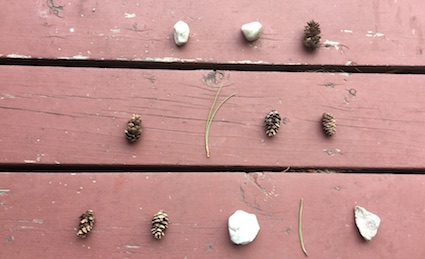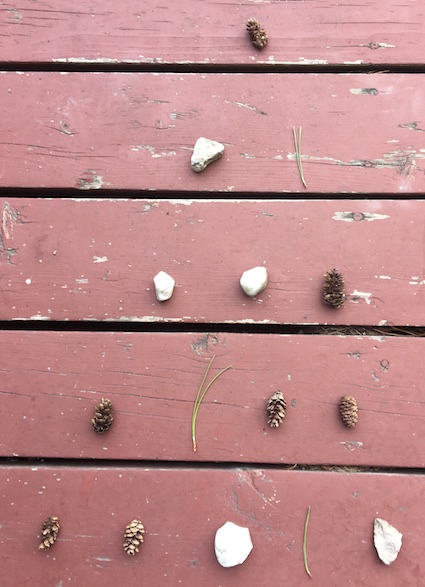
Creating rules to follow in maths provides investigations which can be surprisingly absorbing. In this blog post, aimed at primary-aged children, we begin with ensuring we have three piles of objects. Outside this is easy to gather and can be part of the initial work: with a partner can you gather 20 of each of the following objects: cones, rocks and pine needles. Naturally what your class uses depends upon the materials available. If you are in a concrete jungle, it is worth building up collections of different natural materials for use outside.

Once you have your piles of objects, lay out a sequence of five objects. It does not have to be a pattern unless a child desires this.

Now the cognitive challenge begins. It’s worth demonstrating the building of a pyramid to children and to see if they can work out what you are doing. Here is the second level of the pyramid, I am creating…

And there’s the third level….

And the fourth and fifth levels (I’ve laid this out on a handy wooden decking so you can see the levels of the pyramid)…

The rules I am using are:
- If I have 2 similar objects beside each other, then I must put the same object on the next level. Thus in the photo above, you can see 2 cones beside each other at the base of the pattern and so I have put a cone above these on the next level.
- If two different objects beside each other, then I must put the missing object on the next level. In the above photo, there is a cone and a rock beside each other, so I must put a pine needle on the next level.
It takes a moment or two to fathom this out. Once a child gets the pattern, they can explain it to those who don’t and help them.

Then the fun begins. Ask the children to come up with questions that require investigating, such as:
- Is it possible to create a pattern where you can accurately predict which object will be at the top of the pyramid?
- Does it matter how many levels your pyramid has?
- Can you change the rules in other ways? For example, what happens if you add in more than three types of natural objects? Would this investigation work, if you substituted quantities of objects rather than types?
- What would happen if you reversed the process and began with one object at the top? In what ways does this change the investigation?

From here, encourage the children to look at their maths curriculum and identify which aspects of learning this activity covers. It’s easy to assume it’s all about pattern… but I like the probability, chance and uncertainty discussions which arise from this challenge 🙂
This blog post was originally published in September 2017.





























